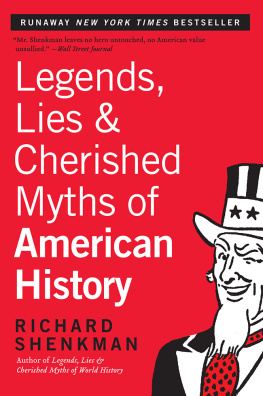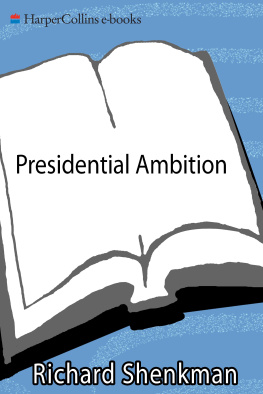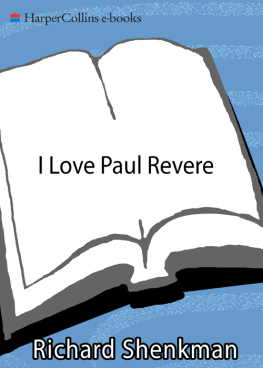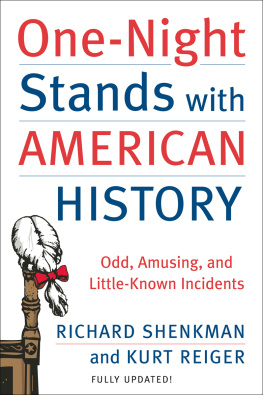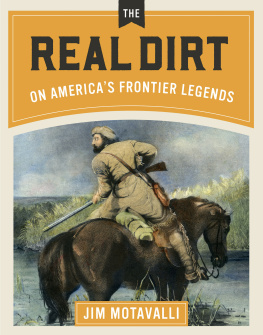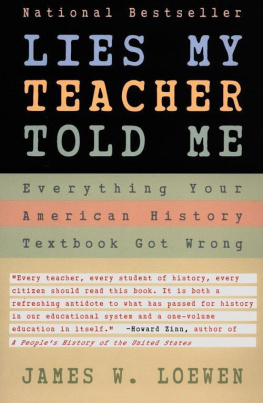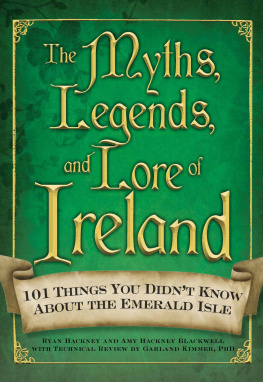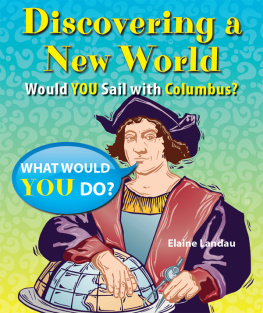To M. J. R.
AMERICANS, DESPITE EVERYTHING
you hear, know plenty of history. They know that the Pilgrims landed on Plymouth Rock, that Teddy Roosevelt charged up San Juan Hill, that Columbus discovered the world is round, and that Eli Whitney invented the cotton gin.
The punch line, of course, is that Americans know all these things but that none of these things are true.
We usually admit that Americans are somewhat ignorant of history, but we dont realize how ignorant. It is not just that a clear majority does not recall that the first ten amendments to the Constitution are known as the Bill of Rights or that people have a hard time remembering that Lincoln was President in the mid-nineteenth century. It is much worse than that. Not only have they forgotten what they should remember, but they have remembered what they should have forgotten.
Thoreau says somewhere that you remember only what is important. What Americans seem to remember from their history, however, is all thats mythical. With time, facts fade. But myths seem to go on and on, whether it is a tale about the Liberty Bell or the nonsense about Lincoln and Ann Rutledge.
Recently Diane Ravitch asked, in a book which revealed that most teenagers are unaware the Constitution was drafted in the second half of the eighteenth century, What do our 17-year-olds know? But what do we adults know?
The answer clearly is: less than we think we do. For as it turns out, even many of the best-known stories from history are false.
Americans are not to blame for knowing so much that is not worth knowing. Even historians have been taken in. Myths are not easy to detect. As E. M. Forster wrote, Nonsense of this type is more difficult to combat than a solid lie. It hides in rubbish heaps and moves when no one is looking.

CHRISTOPHER COLUMBUSS achievements were so great that people have been willing to believe almost anything about him, no matter how fantastic.
Nothing is better known, for instance, than the story that Columbus convinced people the world is round, not flat. Before Columbus proved the world was round, the Encyclopdia Britannica reported in an advertisement for the publication in 1961, people thought the horizon marked its edge. Continued the Britannica: Today we know better.
Indeed we do, one critic has remarked. The authority of the Encyclopdia Britannica notwithstanding, it was Aristotle who proved the world is round, pointing out during an eclipse that the earth casts a spherical shadow on the moon. Plato popularized the concept. By Columbuss day it was taken for granted. The story giving Columbus credit for the discovery did not even surface until after he had died.
The person mainly responsible for the myth was Washington Irving. An obscure writer had mentioned it before, but it was Irving who popularized the story in a dramatic and embellished account. The story appeared not in one of Irvings works of fiction but in what was billed as a biography of Columbus.
In Irvings account, Columbus, in need of funds for his trip to the Indies, goes for help to the sages of the University of Salamanca, whom he tells about his theory that the world is round and that the best way to go east is to sail west. The simple mariner argues for his theory with natural eloquence, in a plea, as it were, for the cause of the new world. Unfortunately Columbus is turned down, the sages being deaf to this entreaty for the exercise of reason and light. Irving laments the outcome but observes: What a striking spectacle must the hall of the old convent have presented at this memorable conference!
As prizewinning historian Samuel Eliot Morison remarks, the story is pure moonshine. Although Columbus did meet with the professors of Salamanca to try to obtain backing for his trip, the sphericity of the globe was not in question. According to Morison, the issue was the width of the ocean. The professors thought Columbus had underestimated the width of the ocean. They were right.
A companion story, just as well known, is that Columbus finally got the money needed for his ocean trip after Queen Isabella had pawned her jewels to finance the venture. Not true. Although the queen offered to sell her jewels if that proved necessary, it did not; the voyage was paid for with government funds.
More controversial is Columbuss reputation as the first European discoverer of America. Determining firsts is often a matter of serious dispute, but in this instance it is not. While Columbus was the first European whose explorations of America had any consequences, he was definitely not the first to explore the New World. The first was a Norseman of whom practically no one has ever heard: Biarni Heriulfson (sometimes Bjarni Herjulfson), whom Morison has dubbed Number One, indubitable European discoverer of America.
Biarni is said to have discovered America by accident. According to Norse sagas, Biarni sighted what is now known to be North America A.D. 985 (or thereabouts), when he was sailing from Iceland to Greenland and was blown off course. After Biarni, other Norsemen made voyages to America. Most notable was the famous Leif Ericsson (son of Eric the Red), who, some fifteen years after Biarni, is thought to have established a little community called Vinland or Newfoundland. The Vinland settlement is said to have lasted about a dozen years until the Norsemen were finally driven off by hostile Indians.

